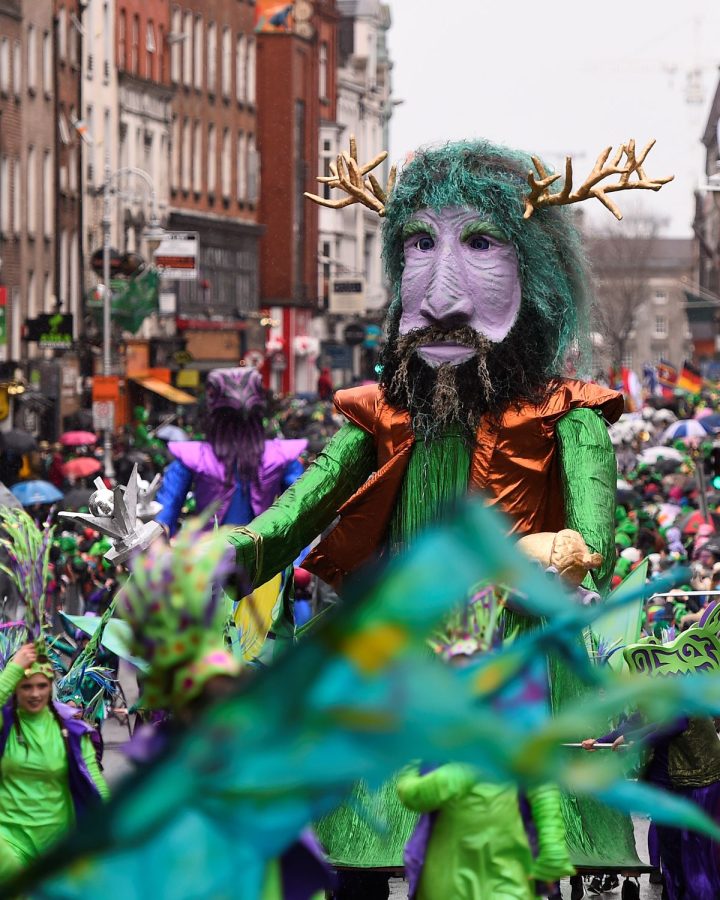St. Patrick’s Day’s Past
March 16, 2022
Each year on March 17th, we celebrate St. Patrick’s Day, the anniversary of the death of St. Patrick in the fifth century. This holiday has been observed by the Irish for over 1,000 years. Who was St. Patrick exactly? Born in Roman Britain, he was kidnapped and brought to Ireland at age 16 as a slave. He was credited with bringing Christianity and peace to the people of Ireland. Following his death, the legends surrounding his life became an essential part of Irish culture. The most famous legend of St. Patrick remained when he explained the Holy Trinity (Father, Son, and Holy Spirit) utilizing the three leaves of the native Irish clover, the shamrock. By the Celts, it was called the “seamroy” and was considered a sacred plant that symbolized the arrival of spring. It was not until the 17th century that the shamrock became a symbol of arising Irish nationalism.
Since the ninth century, people in Ireland have been celebrating the feast day of St.Patrick on March 17. But, surprisingly, the first-ever St. Patrick’s Day Parade was recorded in America, on a Spanish colony known now as St. Augustine, Florida. A century later, Irish soldiers serving in the English military showed their honor to the Irish patron saint and marched through New York City on March 17, 1772. Across the next 35 years, Irish patriotism among Americans thrived, which caused the rise of societies such as the Friendly Sons of Saint Patrick and the Hibernian Society. Each of these groups would hold annual parades starting with bagpipes and drums. These parades quickly became much more popular and a bigger deal.
In 1848, several of these New York societies decided to form one official New York City St. Patrick’s Day Parade. Today, this parade is one of the world’s oldest and largest civilian parades in the United States, with over 150,000 attendees. The procession takes more than 5 hours while nearly 3 million people line the 1.5-mile parade route up 5th Avenue. It is reviewed mainly from the steps of St. Patrick’s Cathedral. Our own Screaming Eagles marching band will be performing in this year’s parade. Like Savannah, Philadelphia, and Chicago, other major cities all celebrate the day with parades with between 10,000 and 20,000 attendees each. Chicago’s annual tradition includes dying the Chicago River Green to commemorate St. Patrick. Unfortunately, due to the COVID-19 pandemic, the last two year’s parades were cancelled for the first time. However, this year’s parade is still scheduled, so people are excitedly anticipating its date.
In Gloucester City, New Jersey they celebrate Irish culture and host an annual St.Patrick’s day parade. According to Bill Quinn, their Committee Chairperson, “Gloucester City boasts a rich history of Irish Heritage dating back to the 1600s when Irish Quakers first settled in the town of Gloucester.” This city celebrates each year to commemorate St. Patrick and the arrival of Christianity in Ireland.
Although St. Patrick’s day is celebrated mainly in the U.S, it is celebrated worldwide in locations far away from Ireland, such as Russia and Japan. One tradition surrounding this day is the Leprechaun. How did leprechauns become a thing? The original Irish name for them is “lobaircin,” meaning “small, bodied fellow.” They are widely known for their trickery used to protect their treasure, such as their “pot of gold.” Finally, a surprising fact that may be shocking to learn about is that corned beef and cabbage was actually an American innovation, not Irish. While ham and cabbage were eaten in Ireland, it was turned into corned beef and cabbage since corned beef was cheaper for impoverished immigrants.


